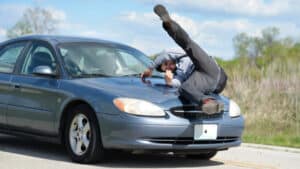Written By Chris Dolan and Cioffi Remmer
This week’s question comes from James from San Francisco who asks: Is jaywalking now legal? Would you please explain the new jaywalking law?
Dear James:
Thanks for your question. We have received several enquiries about this topic and think is worth discussing again. Our office has people who grew up in major cities across the U.S. and often dealt with intense traffic on a daily basis. For example, Mr. Remmer, originally from Chicago, a bustling metropolis, recalls walking the streets of the Loop or the Magnificent Mile, where you could always spot the tourists from the locals by how they treated street-crossing. In cities like Chicago and New York, resident pedestrians, always seemingly in a hurry, do not wait for a white stick-man figure to tell them when they can cross the street. They look both ways, observe no cars coming, and keep moving.
Once Mr. Remmer moved to Los Angeles, in did not take long for him to ditch this practice. Constant anecdotes, refrains, and warnings from friends about receiving “$197 tickets for ‘jaywalking’” elicited the fear he needed to reconsider his street-crossing habit. Law enforcement cited citizens for egregious conduct, as crossing in the middle of the street, or for something as harmless as entering the crosswalk when the countdown signal had already begun.
Even more nefarious, concerned California citizens and activists noticed that these seemingly innocuous citations seemed more to serve as a pretext for police officers to engage in racially biased, unnecessary “stops,” searches, and arrests.
In response, the legislator has passed Assembly Bill 2147, which goes into effect on January 1, 2023. The Freedom to Walk Act would de-criminalize jaywalking. AB2147, (Ting) states in pertinent part as follows:
“Existing law imposes various duties relating to the rules of the road, including, but not limited to traffic signs, symbols, markings, and pedestrians’ rights and duties. Existing law prohibits pedestrians from entering roadways and crosswalks, except under specified circumstances. Under existing law, a violation of these provisions is an infraction. Existing law establishes procedures for peace officers to make arrests for violations of the Vehicle Code without a warrant for offense committed in their presence, as specified.
This bill would prohibit a peace officer, as defined, from stopping a pedestrian for specified traffic infractions unless a reasonably careful person would realize there is an immediate danger of collision with a moving vehicle or other device moving exclusively by human power…” (emphasis added).
The bill incorporates the changes to Section 21456 of the California Vehicle Code, amended as follows:
Veh. Code Sec. 21456
…
(c) A pedestrian facing a circular green signal, unless prohibited by sign or otherwise directed by a pedestrian control signal as provided in Section 21456, may proceed across the roadway within any marked or unmarked crosswalk, but shall yield the right-of-way to vehicles lawfully within the intersection at the time that the signal is first shown.
(d) A pedestrian facing a green arrow turn signal, unless otherwise directed by a pedestrian control signal as provided in Section 21456, shall not enter the roadway.
(e)(1) A peace officer…shall not stop a pedestrian for violation of subdivision (c) or (d) unless a reasonably careful person would realize there is an immediate danger of a collision with a moving vehicle or other device moving exclusively by human power.
…
Assembly Bill 2147, and Vehicle Code 21456(e)(1) do not repeal jaywalking laws. Instead, they define when a police officer can stop, arrest, or cite a pedestrian. While it is unclear if this measure will increase pedestrian safety, it hopes to decrease unnecessary, pretextual police interactions they can weaponize against vulnerable citizens.










